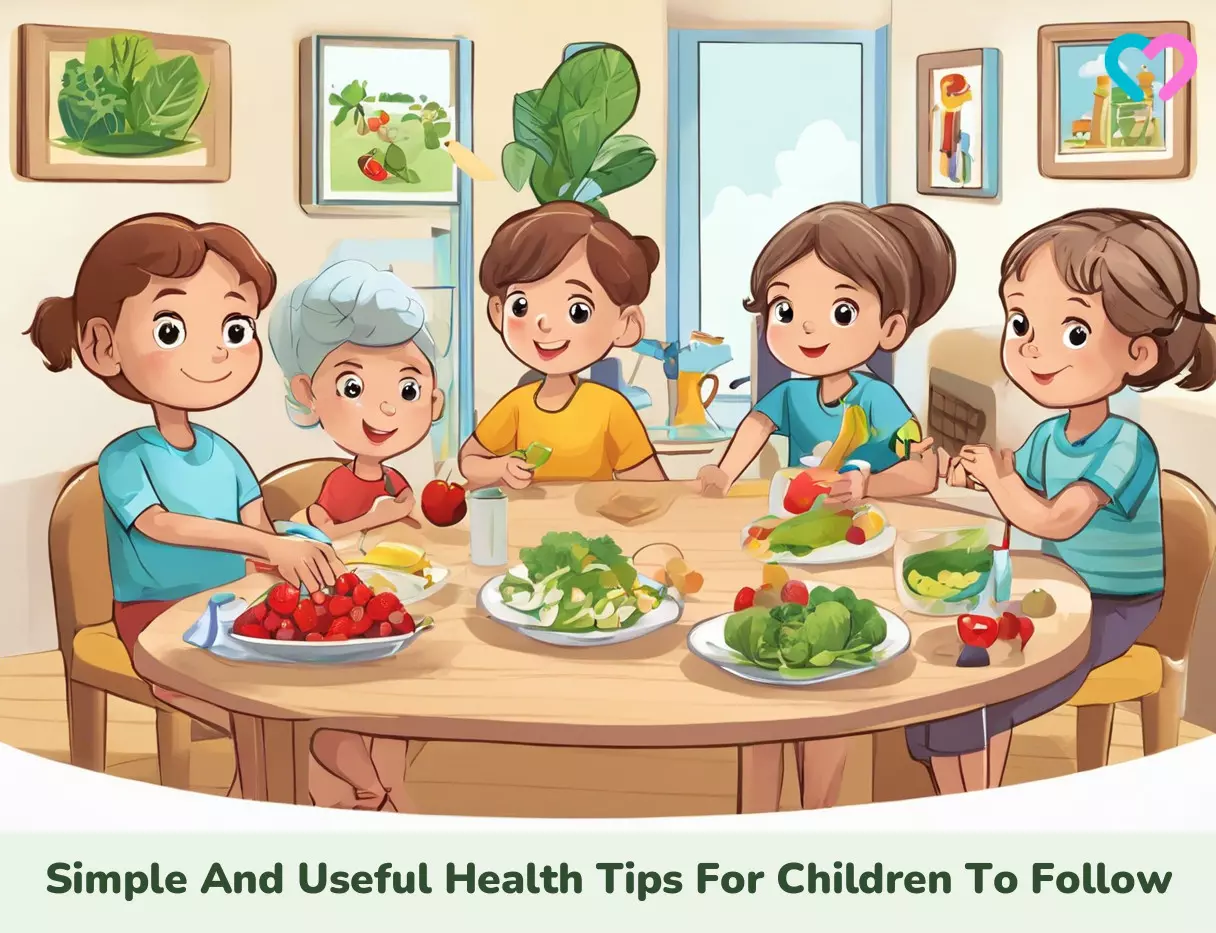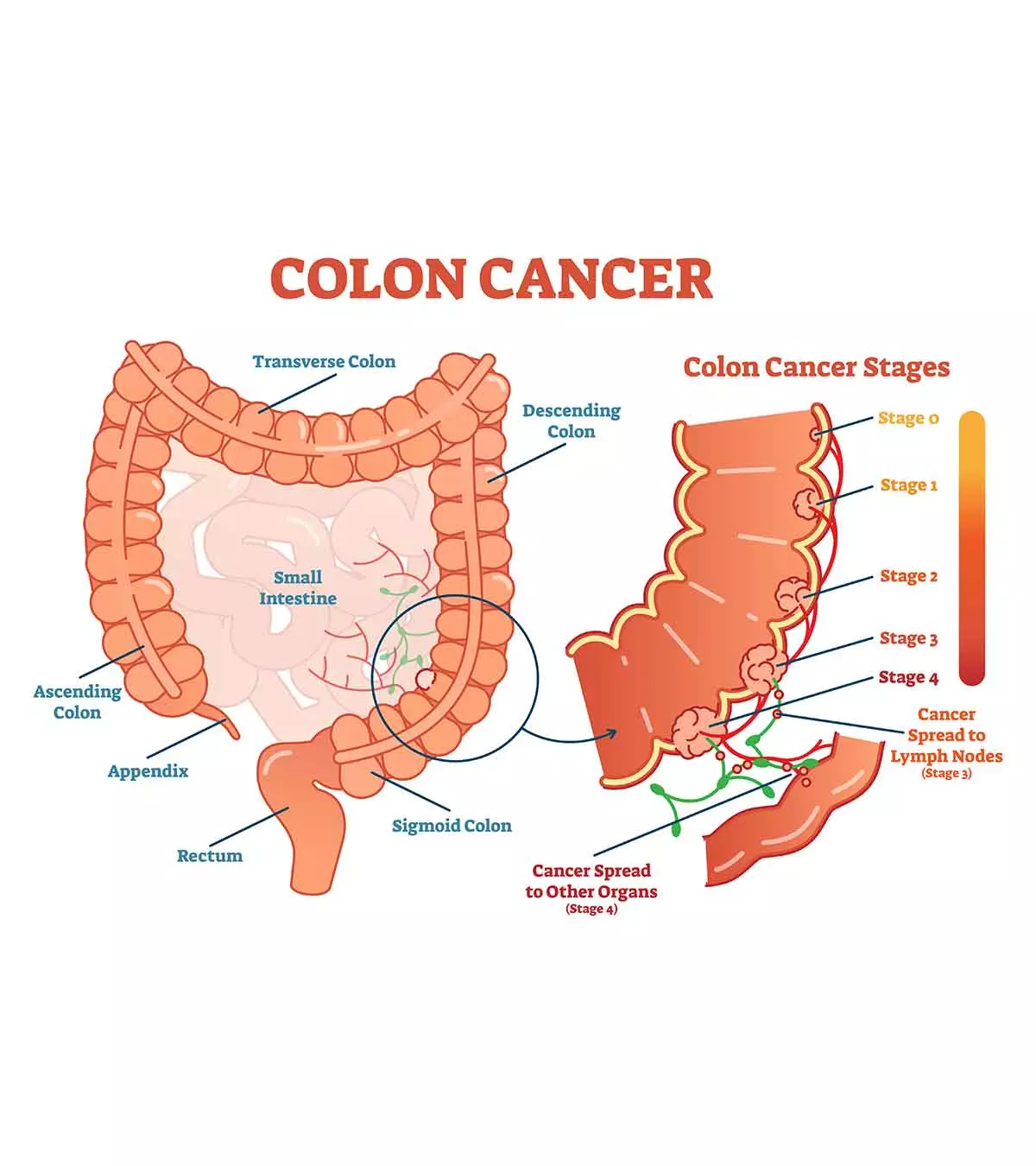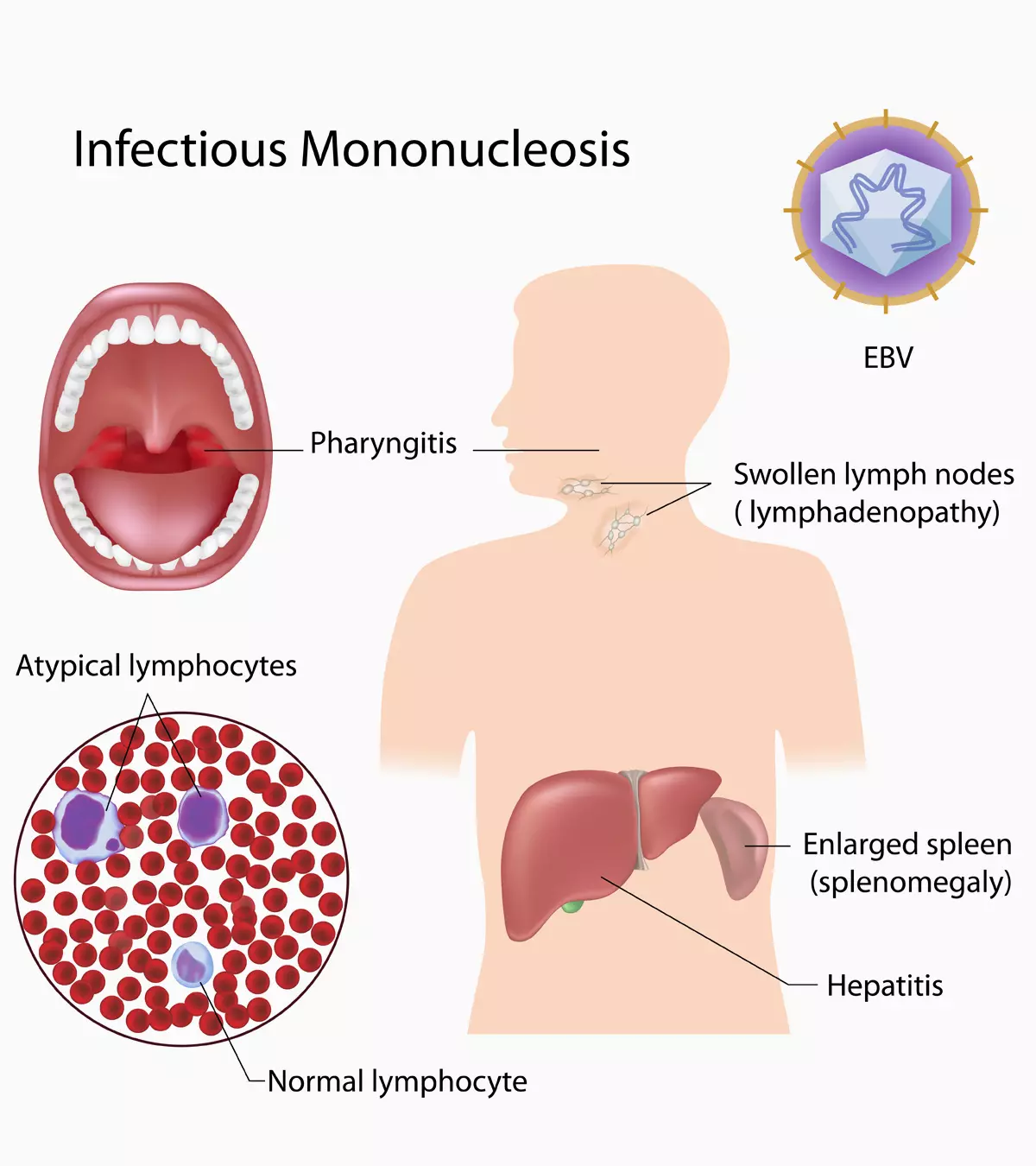
Image: Shutterstock
Parents are constantly on the lookout for health tips for children to ensure they stay fit.

Good health in children depends on several factors, such as their nutrition, hydration, sleep routine, hygiene, and physical activity. It may be difficult for children to ensure they are on the right track for all these parameters by themselves, which is when parents can help.
When children follow a healthy lifestyle, it also lays a strong foundation for good health in the future. Parents should lead by example since children often learn what they see.
Read on as we bring you a list of tips for good health in children.
Key Pointers
- Maintaining your child’s good overall health can be easier if you observe some useful tips about staying healthy.
- For instance, check on their water intake, avoid giving them unhealthy drinks, excess sugars, and forcing them to finish their plates all the time.
- Encourage your child to follow a balanced diet, play a sport daily, practice good hygiene practices, and have routine checkups to secure a healthy present and future.
15+ Essential Health Tips For Children
1. Minimal sugar intake
According to the American Academy of Pediatrics, on average, sugar constitutes 17% of a child’s daily food and beverage consumption (1). Children who receive more than 10% of their daily calories from added sugar are at a higher risk of several health issues, including high cholesterol. There is also a risk of dental problems, in the long term.
It is essential to avoid high-sugar food and, instead, focus on providing the child with healthy alternatives, such as fruits, vegetables, sprouts salad, and homemade cookies.
 Experts say
Experts say2. Drink plenty of water

A significant chunk of our body is made up of water. Water also performs several biological functions, such as excretion of waste, lubrication of joints, and protection of sensitive tissues, such as the spinal cord (2).
Adequate water intake keeps the body hydrated, helps in the regulation of body temperature, and may even help avoid health problems, such as constipation and kidney stones. Experts recommend about two liters of water per day for children older than eight years (3). The quantity may change based on the ambient temperature and physical activity. The simple rule is to teach your child to reach out for water instead of any other beverage each time they feel thirsty.
Sharing how she motivated her son, John, to drink more water, Marla Aycho, a YouTuber and mother, says, “Make it fun. A lot of times, kids just don’t want to drink water. What worked for John was that I would put a big pitcher of water in the fridge and add strawberries, blueberries, lemon, or something to add some flavor and to make infused water. I add it into the sippy cup with the fruit, and he’ll see it and be like, ‘Oh! That looks so cool, I want to drink it.’ It worked really well for John (i).”
3. Check the beverages
Soda and fruit juices with added sugar contain a high amount of sugar and compounds, which may affect overall health. According to the Harvard T.H. Chan School of Public Health, soda contains a high level of phosphates, which can have adverse effects on bone health (4).
Avoid soda and high-sugar fruit juices for kids, and serve healthy beverages instead. A few healthy alternatives are coconut water, low-fat, fortified cow milk, and homemade lemonade. You can also encourage your child to have whole fruit instead of having fruit juices.
4. Avoid the ‘clean plate’ rule
Did you ever set a clean plate rule? If yes, then it is time to change the rules. Children often eat based on their hunger and their sensation of fullness. Forcing a child to clean their plate could lead to overeating and cause unnecessary stress. Also, parents who reward a clean plate with a dessert or other attractive food items may unknowingly cause the child to develop unhealthy food habits.
Experts state that there is no reason to force a child to clean their plate, and children should be left to their own accord when it comes to finishing their meal (5). If your child is a fussy eater, you may experiment with different types of food preparations. However, if your child is underweight, has developmental problems, or consistently eats poorly, speak to a pediatrician or pediatric nutritionist.
5. Occasional desserts

It is okay to have dessert once in a while but avoid serving it regularly. Maintaining an ideal sugar intake is essential for ensuring your child’s overall health and well-being. Many parents and guardians use candies and chocolates to display affection. Keep this practice occasional and limited to special occasions, such as birthdays.
If your child has a sweet tooth, then several naturally sweet food items could be healthy alternatives. A few naturally sweet food items that you could consider to prepare desserts are bananas, sweet potatoes, mangoes, custard apples, and coconut milk.
6. Balanced diet
Children need the right balance of proteins, vitamins, fatty acids, minerals, and carbohydrates for healthy growth.
You can balance each meal with the right amounts of food items that provide all the essential nutrients.
The following are some essential tips for a balanced diet recommended by the Centers for Disease Control and Prevention (6) (7).
There are five food groups, namely vegetables, fruits, protein foods, grains, and dairy. Try serving each meal with a balanced quantity of food items from each food group.
- Preferably about half of a plate/meal should consist of fruits and vegetables. Keep varying between fruits and vegetables so that the child receives wholesome nutrition.
- About half of the child’s daily grain intake should consist of whole grains.
- You can serve low-fat yogurt or milk with a meal. Children aged eight years and older can consume three cups of low-fat milk a day.
- You can vary between several protein-rich foods, such as meat, eggs, nuts, seeds, and legumes.
Ask them to chew their food properly. This ensures good digestion, and the child can sense a full belly as they eat slowly. This reduces the chance of overeating.
 Quick fact
Quick fact7. Frequent meals
You may break the three meals of the day into multiple small servings/portions based on your child’s preference. This method could be useful if the child is a fussy eater. Break the meals into small servings at regular intervals.
For instance, you could break breakfast into two small meals in the morning. You may serve a light lunch followed by a mid-afternoon snack. You could have a pre-dinner food item served, such as a soup, followed by the meal later.
You can experiment with multiple combinations and see what works for your child. You may also speak to a pediatric nutritionist to learn what best works for your child.
8. More fruits and veggies

Fruits and vegetables are rich in fiber, vitamins, and minerals that are essential for healthy organs and immunity (8). Despite their benefits, many children tend to avoid eating fruits and vegetables. To address this, incorporating fruits and vegetables for kids in their diet and try creative strategies that appeal to them.
- Keep fruits such as bananas, apples, and oranges in a basket and place it on the dining table. This will grab the child’s attention when they are hungry. It could make the child more likely to reach out for fruits for snacking than eating junk food.The United States National Center for Health Statistics (NCHS) studied the percentage of children and adolescents aged 2–19 who consumed fruits and vegetables on a given day. The graph below illustrates the findings of the report.According to the results, about 75% of children and adolescents from the mentioned age group consumed any fruit on a given day, with 32% consuming citrus, melons, or berries, 49% consuming other whole fruit and 47% consuming fruit juice. Also, consumption of fruits, including citrus, melons, or berries, other whole fruit, and fruit juice, declined with age.

Percentage of US children and adolescents consuming fruits on a given day
Source: Fruit and Vegetable Consumption Among Children and Adolescents in the United States, 2015–2018; CDC/NCHS- Sneak vegetables in other food. You can stuff shredded vegetables in sandwiches and dumplings. Alternatively, cook stew or soup using vegetables such as carrots, corn, tomatoes, and spinach.
- Prepare vegetable sauce to serve it as an accompaniment with each meal or snack.
- You may also use your imagination to get young children to eat vegetables. For example, serve broccoli pieces by calling them “wonder trees.” Also, try cutting and dressing salads to make them appear interesting.
9. Adequate sleep
Sleep is essential for mental and physical health. It is in sleep that the body repairs itself and improves immune function. Children need adequate sleep for healthy growth (9). Therefore, make sure your child is getting enough sleep each night.
Children between the ages of six and 12 need 9-12 hours of night’s sleep, while teens between 13 and 18 need 8-10 hours of sleep per night. Set a routine of turning off the lights at a fixed time each night. Avoid screen time a few hours before bedtime. If your child has trouble going to sleep, you may observe a relaxing nighttime routine, such as reading a book or listening to music for a fixed duration.
10. Common house rules
Children observe and follow the habits of their parents and siblings. Therefore, it is essential to set the right examples at the house, especially during playtime. Maintain the same rules for all members of the family with no exceptions. For instance, set a fixed time for every member to go to bed.
Common rules for all help reinforce healthy habits among children. Talking therapy can also be a helpful tool for parents and siblings to reinforce positive habits and behaviors among each other. The child is also less likely to take any rule or instruction lightly since they notice their siblings and parents follow the same rules, too.
11. Encourage sports
Teenagers can spend about seven to nine hours each day in front of screens, such as television and smartphones (10). An increase in screen time can lead to a sedentary lifestyle, which could increase the risk of excess weight gain.
Experts recommend limiting screen time in children to a couple of hours a day (11). Approximately 85% of girls globally between the ages of ten and 19 fail to meet the World Health Organization’s recommendation of engaging in at least 60 minutes of moderate to vigorous physical activity daily. Similarly, the proportion of boys not reaching this activity threshold is approximately 78%. Motivating children to participate in sports and other activities, such as cycling, is important to ensure they achieve a minimum of one hour of physical activity every day (12). If you do not have outdoor sports facilities, you may play simple indoor games or plan an indoor exercise routine involving movement. Examples include indoor hopscotch, hula hoop, treasure hunt, dancing, and building a tunnel with old cartons. You could also use exercise equipment, such as indoor cycles, to get the child active.
 Quick tip
Quick tip12. Correct supplementation

It is common for parents to serve a malt-based supplement dissolved in milk to children. A few other examples of supplements include chewable calcium candies, vitamin candies, and fish oil tablets. Most supplements contain nutrients necessary for the child’s growth. However, the child’s nutritional requirements could vary based on their age, weight, gender, and physical activity.
Most children can get their daily nutrition from a balanced diet without the need for supplements. Also, the use of incorrect supplements may provide no benefits and may increase the risk of weight gain (13). Therefore, if you wish to give your child nutritional supplements, seek professional support from a pediatrician to ensure your child’s safety.
13. Vaccination
According to the World Health Organization, vaccination reduces the risk of disease and helps an immunized individual live longer and healthier (14). Many parents worry about the potential side effects of a vaccine. However, the side effects are mostly mild, and the benefits of the vaccine outweigh the risks of catching a disease (15).
Make sure all in your family are immunized. Maintain a vaccination record of your child and each member of the household, and get immunized in a timely way for the best protection against illnesses.
14. Correct posture
Most children end up slouching on their chairs. Encourage the use of study table while studying. Prevent them from reading/ writing while lying on the bed. The right posture can help more than just the musculoskeletal system of the body. Maintaining the right static posture while seated and a dynamic posture while walking keeps the muscles flexible, reduces the risk of falling, and may even improve digestion and breathing (16).
According to the Harvard Medical School, the following are the key attributes of a good posture while sitting and standing (17).
- Chin stays parallel to the ground
- Spine stays in a neutral position with no flexing or arching
- Shoulder stay straight and even
- Abdominal muscles held in a neutral firm position
- Knees at an even height and straight
- Bodyweight evenly distributed on both feet while standing and walking
15. Good hygiene
Hygiene is equally important as a balanced diet and physical activity. The right hygiene helps protect the body against disease-causing germs. Teach your child healthy hygiene habits, such as using a tissue while sneezing or coughing, throwing away tissues after sneezing, and not sharing personal items with others.
Hand-washing is an important hygiene measure, which can protect against several illnesses, including COVID-19 (18). Teach your child to wash their hands each time they come from outdoors, before eating meals, and after using the toilet. Make hygiene practices fun for kids with games or challenges, like handwashing contests. When outdoors, use an alcohol-based sanitizer to disinfect the hands. You may let the child carry sanitizer when they go to school.
16. Oral health

Children must brush twice a day, once in the morning and once at night (19). Your child may have to brush more often if they are wearing braces. Teach your child the right way of brushing their teeth. You may also encourage the child to floss once a day to remove any food particles stuck between the teeth.
You may speak to a dentist to learn the right way to brush. The dentist may also be able to recommend the ideal toothbrush and toothpaste for your child’s age.
17. Regular check-ups
Each health tip leads to better health and growth of your child. However, you also need to keep track of the child’s health. It is good to keep track of your child’s height, weight, blood pressure, and sugar level. You may speak to a pediatrician who can suggest the right schedule to check the essential health parameters of the child as per their age and health status.
Frequently Asked Questions
1. What is child health care?
Child health care is a term used to describe the importance of physical, emotional, and overall growth in children and providing prompt medical interventions to manage preventable health conditions or treat the unwell (20).
2. What is the definition of a healthy child?
According to the Centers for Disease Control and Prevention (CDC), healthy development in children can be defined as the ability of children (including those with special care needs) to grow up in a healthy and safe environment where their emotional, social, and educational needs are covered (21).
3. Why is my child’s health important?
The World Health Organization (WHO) states that protection and improvement of a child’s health are crucial to building a better and healthy future for them. Furthermore, in addition to a stable environment, good health, protection from illnesses, and a nutritious diet, access to learning opportunities are also vital for their well-being and future development (22).
4. How many calories should my child eat in a day?
The amount of calories a child requires per day depends on age, weight, physical activity, and height. However, a rough estimation indicates that toddlers between the age of one to three require about 1,000 and 1,400 calories a day. Girls above four need between 1,400 and 2,200 calories daily, while boys need between 1,600 and 2,600 calories daily (25).
5. Do healthy kids learn better?
Healthy habits go a long way in protecting children from diseases and ensuring their well-being. Since all good habits start at home, it is a good idea to introduce health tips for children mentioned above to them. This practice will ensure that good habits become natural to children, so they don’t have to consciously develop them after they grow up. So, encourage your children to eat less sugar, drink adequate water, eat more fruits and vegetables, and participate in sports. Also, learning good habits together as a family can improve the bonding and is easier and more fun.
Infographic: Plan A Week To Support Your Child’s Health
A healthy childhood builds a foundation for a healthy future. Therefore, it is of utmost importance to take the mandated steps to facilitate good health in children. This infographic details how you can plan and focus each day of the week on enhancing your child’s overall health.
Some thing wrong with infographic shortcode. please verify shortcode syntax
Illustration: Simple And Useful Health Tips For Children To Follow

Image: Stable Diffusion/MomJunction Design Team
Watch this video to understand the four fundamental rules for healthy growth: nourish your body with nutritious food, engage in physical activity, prioritize sufficient sleep, and stay hydrated.
Personal Experience: Source
MomJunction articles include first-hand experiences to provide you with better insights through real-life narratives. Here are the sources of personal accounts referenced in this article.
i. How to get your toddler to drink more water.https://www.youtube.com/watch?feature=shared&v=vb1c545DYMY
References
1. How to Reduce Added Sugar in Your Child’s Diet: AAP Tips; American Academy of Pediatrics
2. About Water and Healthier Drinks; Centers for Disease Control and Prevention
3. How Much Water Should My Child Drink?; CHOC
4. Sugary Drinks; Harvard T.H. Chan School of Public Health
5. No More “Clean Plate Club“; American Academy of Pediatrics
6. What is MyPlate?; U.S. Department of Agriculture
7. 10 Tips: Got Your Dairy Today?; U.S. Department of Agriculture
8. Joanne L. Slavin and Beate Lloyd (2012); Health Benefits of Fruits and Vegetables; American society for nutrition
9. Sleep Deprivation and Deficiency; National Institutes of Health
10. Screen Time vs. Lean Time Infographic; Centers for Disease Control and Prevention
11. Screen time and children; U.S. National Library of Medicine
12. Physical Activity for Children: An Overview; Centers for Disease Control and Prevention
13. Nutrition and Supplement Use; American Academy of Pediatrics
14. Vaccines and immunization; World Health Organization
15. Five Important Reasons to Vaccinate Your Child; U.S. Department of Health and Human Services
16. Guide to Good Posture; U.S. National Library of Medicine
17. Why good posture matters; Harvard Medical School
18. Coronavirus disease (COVID-19) advice for the public; World Health Organization
19. Toothbrushing; Better Health Channel
20. Health Insurance and Access to Care; America’s Children: National Library of Medicine
21. Healthy Habits: Child Development; Centers for Disease Control and Prevention
22. Child health; World Health Organization
23. Healthy kids ‘sweet enough’ without added sugars; Harvard T.H. Chan
24. Physical activity for children and youth; Caring For Kids
25. Should your children diet? How many calories do they need?; Children’s MD
26. Health and Academics; Centers for Disease Control and Prevention
27. Physical Activity, Fitness, and Physical Education: Effects on Academic Performance; NCBI
Community Experiences
Join the conversation and become a part of our nurturing community! Share your stories, experiences, and insights to connect with fellow parents.
Read full bio of Dr. Anuradha Bansal
Read full bio of Sravani Rebbapragada
Read full bio of Dr. Ritika Shah
Read full bio of Dr. Joyani Das
















